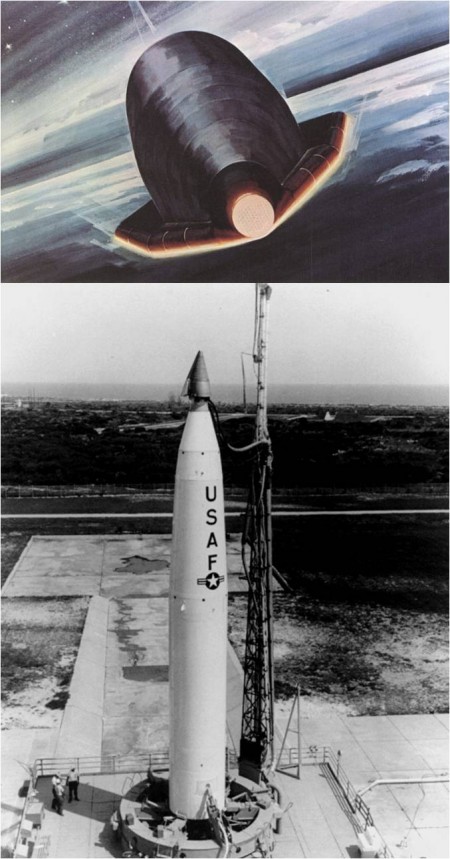Forty-nine years ago this month, the first ASSET flight test vehicle successfully flew 1,600 nm down the Eastern Test Range following launch from Cape Canaveral, Florida. Boosted atop a Thor launch vehicle, the hypersonic glider reached a maximum velocity of 10,900 mph (Mach 12).
The Aerothermodynamic/Elastic Structural Systems Environmental Tests (ASSET) Program was a United State Air Force flight research effort aimed at exploring hypersonic lifting entry. Programmatic objectives included evaluation of hypersonic lifting vehicle (1) reentry aerodynamic and aerothermodynamic phenomena (2) structural design concepts, and (3) panel flutter characteristics and body flap oscillatory pressures.
The basic ASSET vehicle configuration was a 70-deg delta planform wing with highly-radiused leading edges. The windward surface of this wing was flat and had a 10-deg break in slope roughly two-thirds of the way back from the nose. A blunted cone-cylinder combination was raked into the leeward surface of the wing to form the fuselage of the vehicle. The aft portion of the vehicle was terminated with a flat base region.
There were two (2) types of ASSET vehicles. The Aerothermoelastic Vehicle (AEV) variant was flown to investigate windward panel flutter characteristics and body flap oscillatory pressures. A pair of these vehicles were flown. Each weighed AEV weighed 1,225 lbs and was launched into a suborbital flight path by a Douglas Thor booster.
The Aerothermodynamic Structural Vehicle (ASV) variant was flown to determine external airframe surface temperature, heat flux and pressure distributions in hypersonic flight. These data were used to evaluate materials and structural concepts under reentry conditions. A quartet of these vehicles were flight tested. Each ASV weighed 1,130 lbs and was boosted by a Thor-Delta launch vehicle.
ASSET vehicles were boosted to altitudes between 168 KFT and 225 KFT depending on mission type. AEV entry insertion velocity was roughly 13,000 ft/sec while that for ASV shots varied between 16,000 and 19,500 ft/sec. ASSET performed hypersonic flight maneuvers via a combination of aerodynamic and propulsive controls. The windward-mounted body flap was the lone aerodynamic control surface while a set of 3-axis attitude control thrusters were located in the vehicle’s base region.
The first flight of the ASSET Program (ASV-1) took place on Wednesday, 18 September 1963. ASV-1 lift-off occurred at 09:39 UTC from Cape Canaveral’s LC-17B. Due to booster availability issues, a Thor DSV-2F launch vehicle was used for this mission rather than the higher energy Thor-Delta DSV-2G. Insertion altitude and velocity were 203,200 ft and 16,125 ft/sec, respectively. The ASV-1 mission was highly successful with the exception that the vehicle was lost when it sunk in the South Atlantic during recovery operations.
ASV-1 represented the first time in aerospace history that a lifting vehicle configuration had successfully flown a double-digit Mach number reentry trajectory. Five (5) more ASSET vehicles would fly before completion of the flight research program. The sixth and last mission occurred on Tuesday, 23 February 1965.
The ASSET Program garnered a wealth of first-ever hypersonic vehicle aerodynamic, aerothermodynamic, aerothermoelastic and flight controls data. This priceless information and the valuable experience gained during ASSET contributed significantly to the design and flight testing of the PRIME SV-5D and Space Shuttle Orbiter.
Strangely, only one of the ASSET flight test articles was ever recovered successfully. In particular, ASV-3 was recovered following its 1,800 nm suborbital flight down the Eastern Test Range on Wednesday, 22 July 1964. The recovered airframe is currently on display at the National Museum of the United States Air Force in Dayton, Ohio.

